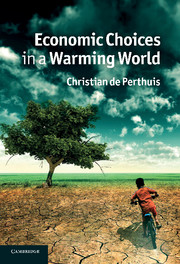Book contents
- Frontmatter
- Contents
- Acknowledgements
- Introduction
- 1 Climate risk
- 2 Some like it hot: adaptation to climate change
- 3 Building a low-carbon energy future
- 4 Pricing carbon: the economics of cap-and-trade
- 5 Intensifying agriculture to safeguard forests
- 6 The price of carbon: the economics of projects
- 7 Macroeconomic impacts: sharing carbon rent
- 8 International climate negotiations
- Conclusion
- References
- Appendix 1 Thirty key readings
- Appendix 2 Thirty key sets of figures
- Appendix 3 Greenhouse gas emissions around the world
- Glossary
- Index
1 - Climate risk
Published online by Cambridge University Press: 05 June 2012
- Frontmatter
- Contents
- Acknowledgements
- Introduction
- 1 Climate risk
- 2 Some like it hot: adaptation to climate change
- 3 Building a low-carbon energy future
- 4 Pricing carbon: the economics of cap-and-trade
- 5 Intensifying agriculture to safeguard forests
- 6 The price of carbon: the economics of projects
- 7 Macroeconomic impacts: sharing carbon rent
- 8 International climate negotiations
- Conclusion
- References
- Appendix 1 Thirty key readings
- Appendix 2 Thirty key sets of figures
- Appendix 3 Greenhouse gas emissions around the world
- Glossary
- Index
Summary
November 2006, Moscow. The temperature is unusually mild. Animal species, governed by the rhythm of the seasons, are unsettled. The bears in the zoo are having trouble hibernating and need to be given additional food. Several species of migratory birds, which have left on their annual journey, are turning back. Disoriented ducks are engaging in courtship displays.
April 2007, France. With temperatures 4.7°C higher than the thirty-year average, it is the warmest April ever recorded by Météo France. Crops are particularly advanced for the time of year, up to three weeks early for grains. Strawberries and cherries from south-west France are already on the market. This earliness is no one-off occurrence. Since 1945, grape harvest dates have advanced by three weeks, even a month, in certain regions. As the French historian Emmanuel Le Roy Ladurie makes clear, variations in harvest dates, recorded in parish registers since the Middle Ages, are reliable evidence for historical fluctuations in temperature.
December 2007, New South Wales, Australia. The small town of Deniliquin invested in the largest rice production programme in the southern hemisphere. In its heyday, it was able to meet the needs of 20 million people around the world. But after five consecutive years of drought, the factory has recently closed. Australian farmers have abandoned rice growing, with its heavy demand for water. The country's exports have fallen, which has contributed to food riots in Africa and the Caribbean. Of course, this is not the first time Australia has experienced drought.
- Type
- Chapter
- Information
- Economic Choices in a Warming World , pp. 8 - 33Publisher: Cambridge University PressPrint publication year: 2011



